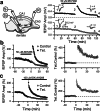Assessing the role of Ih channels in synaptic transmission and mossy fiber LTP
- PMID: 12093909
- PMCID: PMC123176
- DOI: 10.1073/pnas.142213199
Assessing the role of Ih channels in synaptic transmission and mossy fiber LTP
Abstract
Hyperpolarization-activated nonselective cation channels (Ih channels) play an important role in the control of membrane excitability and rhythmic neuronal activity. The functional relevance of presynaptic Ih channels in regulating synaptic function, however, is not well established. Recently, it has been proposed [Mellor, J., Nicoll, R. A. & Schmitz, D. (2002) Science 295, 143-147] that presynaptic Ih channels are necessary for hippocampal mossy fiber long-term potentiation (LTP). This observation challenges an alternative model that suggests presynaptic forms of LTP are caused by a direct modification of the transmitter release machinery. Here, we assess the role of Ih in hippocampal mossy fiber LTP as well as cerebellar parallel fiber LTP, forms of potentiation that share common mechanisms. Our results show that after Ih blockade neither mossy fiber LTP nor parallel fiber LTP are affected. Furthermore, Ih does not significantly modify basal excitatory synaptic transmission in the hippocampus, whereas the organic Ih blockers ZD7288 and DK-AH 269 induce a large Ih-independent depression of synaptic transmission. In summary, our results indicate that Ih-mediated persistent changes in presynaptic excitability do not underlie presynaptic forms of LTP.
Figures







Similar articles
-
Mediation of hippocampal mossy fiber long-term potentiation by presynaptic Ih channels.Science. 2002 Jan 4;295(5552):143-7. doi: 10.1126/science.1064285. Science. 2002. PMID: 11778053
-
Hippocampal mossy fiber calcium transients are maintained during long-term potentiation and are inhibited by endogenous zinc.Brain Res. 2004 Apr 9;1004(1-2):52-60. doi: 10.1016/j.brainres.2004.01.013. Brain Res. 2004. PMID: 15033419
-
Presynaptic kainate receptors impart an associative property to hippocampal mossy fiber long-term potentiation.Nat Neurosci. 2003 Oct;6(10):1058-63. doi: 10.1038/nn1116. Epub 2003 Aug 31. Nat Neurosci. 2003. PMID: 12947409
-
Long-term potentiation of synaptic transmission at the mossy fiber-granule cell relay of cerebellum.Prog Brain Res. 2005;148:69-80. doi: 10.1016/S0079-6123(04)48007-8. Prog Brain Res. 2005. PMID: 15661182 Review.
-
Synaptic plasticity at the cerebellum input stage: mechanisms and functional implications.Arch Ital Biol. 2005 May;143(2):143-56. Arch Ital Biol. 2005. PMID: 16106995 Review.
Cited by
-
HCN4 provides a 'depolarization reserve' and is not required for heart rate acceleration in mice.EMBO J. 2007 Oct 31;26(21):4423-32. doi: 10.1038/sj.emboj.7601868. Epub 2007 Oct 4. EMBO J. 2007. PMID: 17914461 Free PMC article.
-
HCN2 and HCN1 channels govern the regularity of autonomous pacemaking and synaptic resetting in globus pallidus neurons.J Neurosci. 2004 Nov 3;24(44):9921-32. doi: 10.1523/JNEUROSCI.2162-04.2004. J Neurosci. 2004. PMID: 15525777 Free PMC article.
-
The hyperpolarization-activated channel HCN4 is required for the generation of pacemaker action potentials in the embryonic heart.Proc Natl Acad Sci U S A. 2003 Dec 9;100(25):15235-40. doi: 10.1073/pnas.2434235100. Epub 2003 Dec 1. Proc Natl Acad Sci U S A. 2003. PMID: 14657344 Free PMC article.
-
Missing Puzzle Pieces in Dementia Research: HCN Channels and Theta Oscillations.Aging Dis. 2024 Feb 1;15(1):22-42. doi: 10.14336/AD.2023.0607. Aging Dis. 2024. PMID: 37450922 Free PMC article. Review.
-
Enhancement of Ih, but not inhibition of IM, is a key mechanism underlying the PACAP-induced increase in excitability of guinea pig intrinsic cardiac neurons.Am J Physiol Regul Integr Comp Physiol. 2009 Jul;297(1):R52-9. doi: 10.1152/ajpregu.00039.2009. Epub 2009 Apr 29. Am J Physiol Regul Integr Comp Physiol. 2009. PMID: 19403861 Free PMC article.
References
Publication types
MeSH terms
Substances
LinkOut - more resources
Full Text Sources

